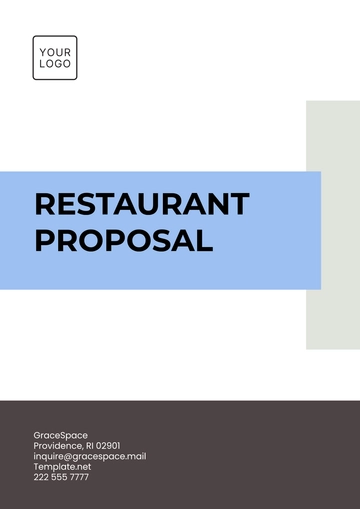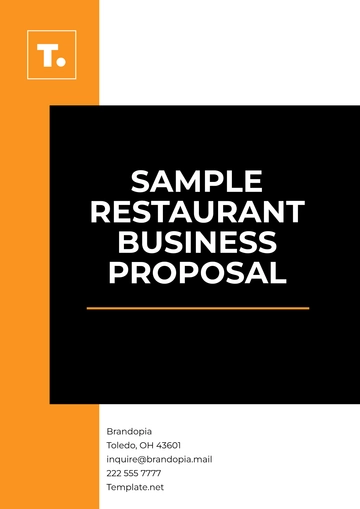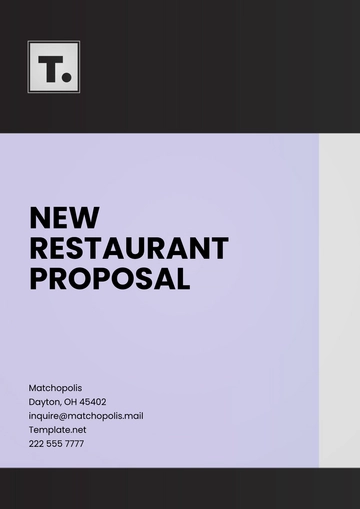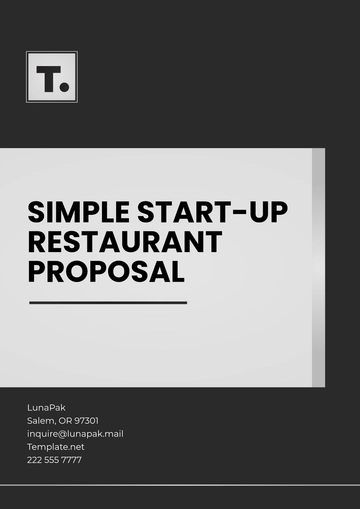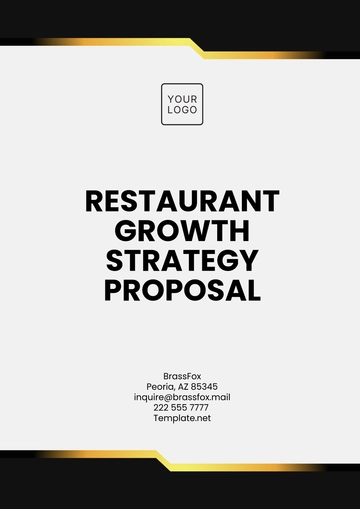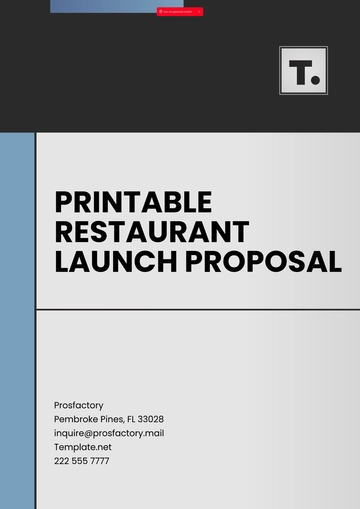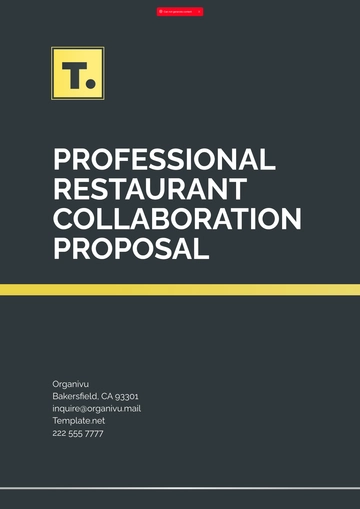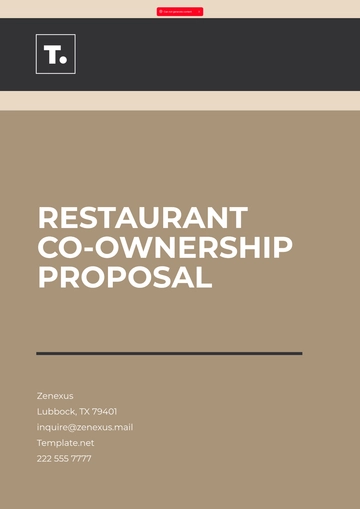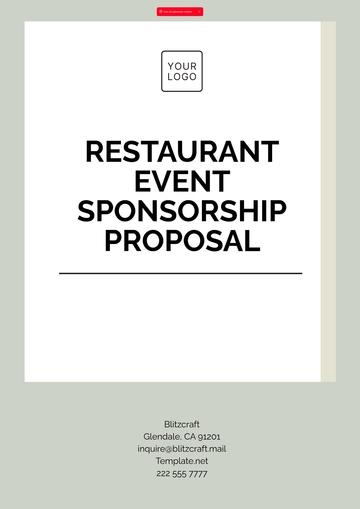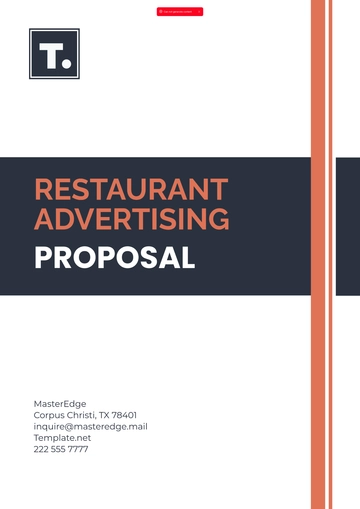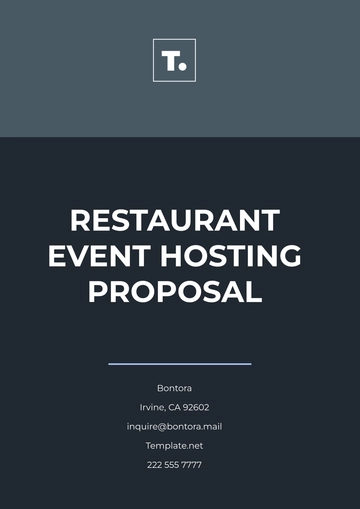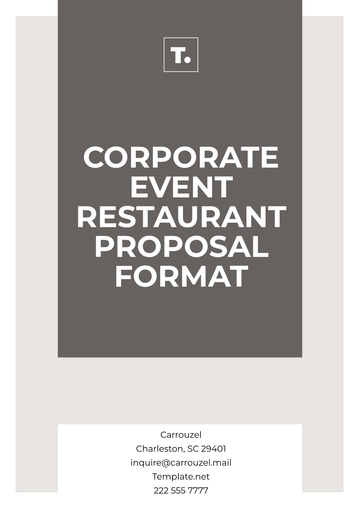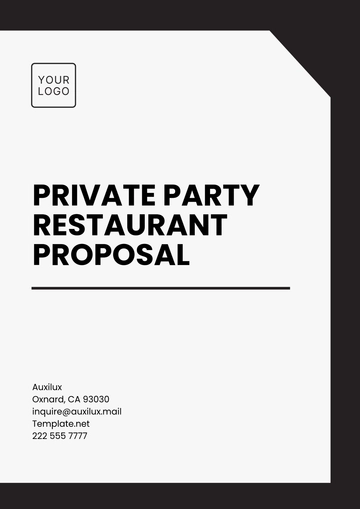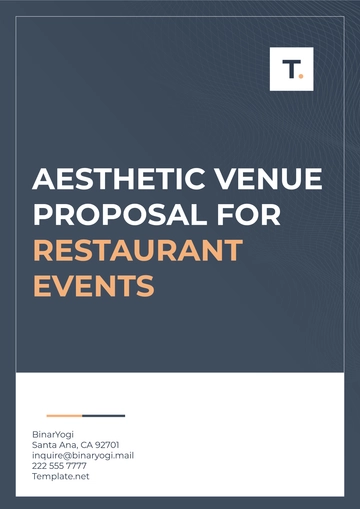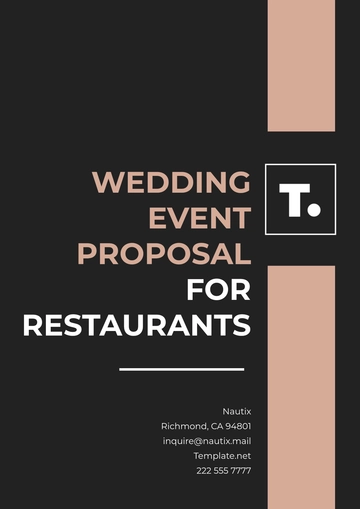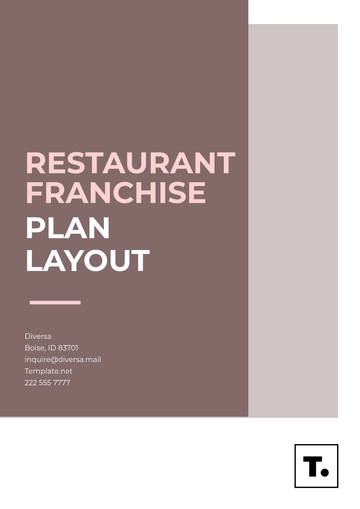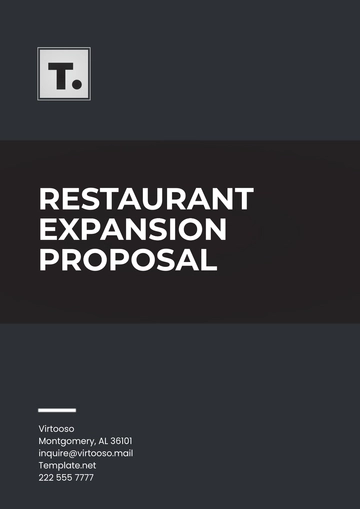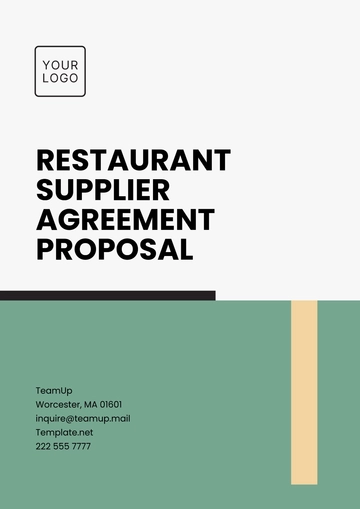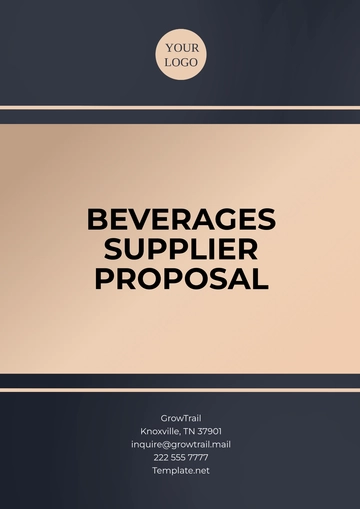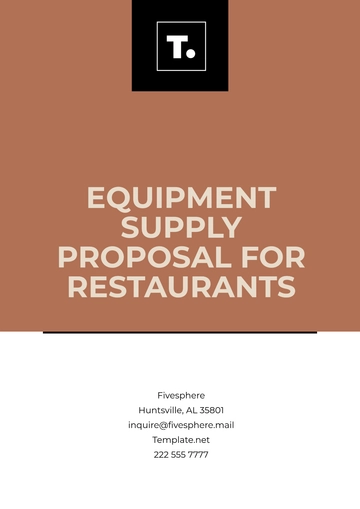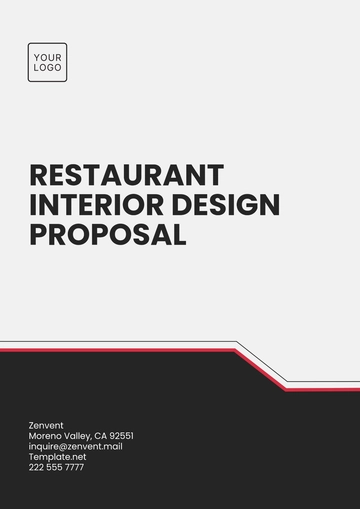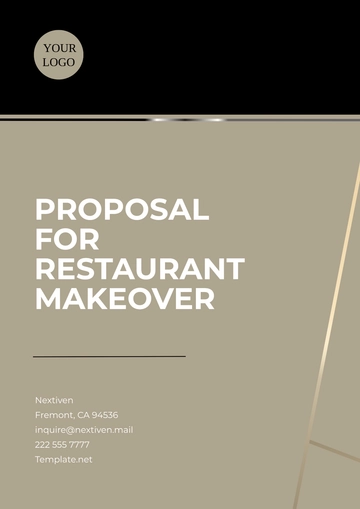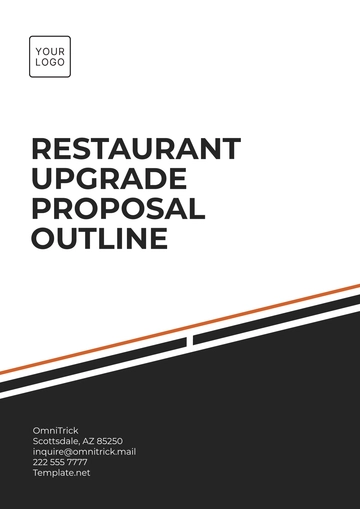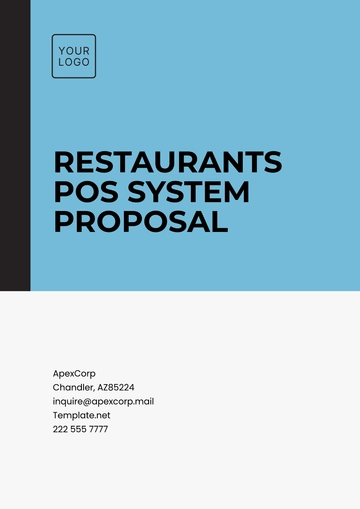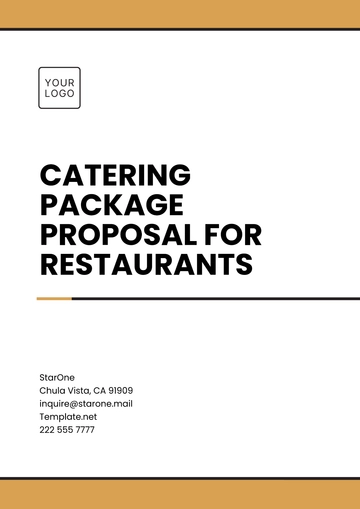Free Restaurant Investor Proposal
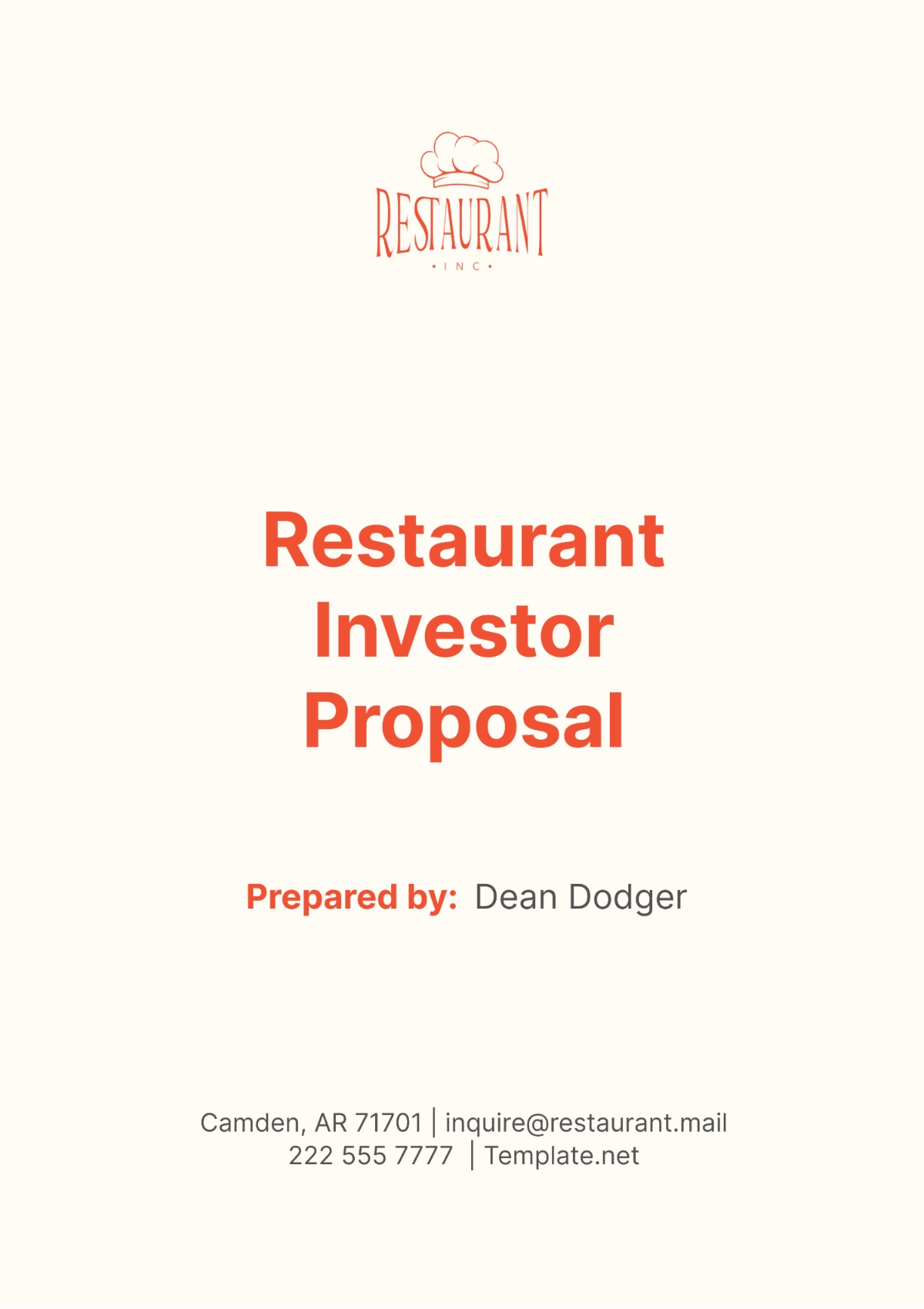
I. Executive Summary
We are excited to present an investment opportunity in our innovative restaurant concept. Our restaurant offers a unique dining experience centered around a modern twist on traditional cuisine, with an emphasis on locally sourced ingredients and sustainable practices. Our mission is to provide exceptional food and service in a welcoming atmosphere, appealing to both local residents and visitors.
Key Financial Highlights
Projected Annual Revenue (Year 1): $1,200,000
Projected Annual Revenue (Year 2): $1,500,000
Net Profit Margin (Year 1): 15%
Break-Even Point: 18 months
Total Funding Required: $500,000
Expected ROI: 25% per annum
II. Business Description
Our restaurant concept combines a contemporary setting with a menu that celebrates local flavors and innovative culinary techniques. Located in the heart of a bustling downtown area, we cater to a diverse target market including young professionals, families, and food enthusiasts. Our unique selling points (USPs) include an ever-changing seasonal menu, a commitment to sustainability, and a dining environment that blends comfort with modern aesthetics.
III. Market Analysis
A. Industry Overview
The restaurant industry is experiencing significant growth, driven by increasing consumer demand for unique dining experiences and high-quality food. According to industry reports, the market size is expected to reach $899 billion by [Year], growing at a CAGR of 3.7%. The trend towards sustainability and local sourcing is particularly prominent, with 75% of consumers willing to pay more for sustainably sourced ingredients.
B. Target Market
Our target market comprises urban professionals, families, and tourists who value quality dining experiences. The following table outlines the demographics and needs of our primary customer segments:
Demographic | Income Level | Key Needs |
|---|---|---|
Young Professionals | $50,000-$100,000 | Quick service, healthy options |
Families | $75,000-$150,000 | Kid-friendly, diverse menu options |
Food Enthusiasts | $40,000-$120,000 | Unique flavors, dining experience |
Tourists | Varies | Local cuisine, memorable atmosphere |
C. Competitive Analysis
The competitive landscape features a mix of established restaurants and new entrants, each with its own strengths and weaknesses. The table below provides an analysis of key competitors:
Competitor | Share (%) | Strengths | Weaknesses |
|---|---|---|---|
A | 15 | Strong brand recognition | Higher price points |
B | 10 | Popular with tourists | Limited menu options |
C | 8 | Extensive menu | Inconsistent quality |
D | 12 | Excellent customer service | Less focus on local sourcing |
Despite a competitive market, our restaurant stands out due to our commitment to sustainability, a dynamic menu that changes with the seasons, and a dining experience that prioritizes both quality and ambiance. Our unique approach positions us favorably against competitors, offering a compelling reason for customers to choose us over others.
IV. Marketing and Sales Strategy
Our marketing and sales strategy focuses on leveraging both online and offline channels to attract and retain customers. By creating a strong brand presence and engaging with our target market, we aim to build a loyal customer base and drive consistent revenue growth.
Digital Marketing: Utilize social media platforms, search engine optimization (SEO), and email marketing to reach a wider audience.
Local Advertising: Partner with local publications and radio stations to promote the restaurant.
Events and Promotions: Host special events and offer promotions to attract new customers and encourage repeat visits.
Loyalty Program: Implement a rewards program to incentivize repeat business.
Community Engagement: Participate in local events and sponsor community activities to build brand awareness and goodwill.
V. Operational Plan
A. Restaurant Layout and Design
Our restaurant will feature a contemporary design with a focus on comfort and aesthetics. The layout includes a spacious dining area, an open kitchen, and a bar area. The interior design will incorporate natural elements and sustainable materials to create a welcoming and eco-friendly environment.
B. Menu and Pricing Strategy
Our menu will showcase a variety of dishes made from locally sourced ingredients, offering a balance of traditional and innovative flavors. Pricing will be competitive, reflecting the quality of the ingredients and the dining experience. The following table provides a sample of our menu items and their prices:
Menu Item | Price ($) |
|---|---|
Seasonal Salad | 12 |
Grilled Chicken Sandwich | 15 |
Vegan Burger | 14 |
Seafood Pasta | 18 |
Chocolate Lava Cake | 8 |
Craft Cocktails | 10 |
C. Staffing Plan
Our staffing plan ensures that we have the right number of employees to provide excellent service while maintaining cost efficiency. The table below outlines our staffing needs:
Position | Number of Employees |
|---|---|
Head Chef | 1 |
Sous Chefs | 2 |
Line Cooks | 4 |
Servers | 6 |
Bartenders | 2 |
Host/Hostess | 2 |
Dishwashers | 3 |
Management Staff | 2 |
D. Management Team
Our management team consists of experienced professionals with a proven track record in the restaurant industry. The table below outlines the roles and responsibilities of key management team members:
Role | Responsibilities |
|---|---|
General Manager | Oversee daily operations, financial management |
Head Chef | Menu development, kitchen management |
Marketing Manager | Develop and implement marketing strategies |
Operations Manager | Inventory management, supplier relations |
E. Supplier and Inventory Management
Our supplier and inventory management process focuses on sourcing high-quality, locally produced ingredients. We will establish relationships with trusted suppliers to ensure consistent quality and availability of products. Inventory will be monitored regularly to minimize waste and optimize stock levels. This process includes weekly supplier orders, daily inventory checks, and a robust inventory management system to track usage and reduce spoilage.
VI. Financial Plan
A. Start-Up Costs
Our start-up costs cover all necessary expenses to launch the restaurant and ensure smooth operations from day one. These costs include leasehold improvements, kitchen equipment, initial inventory, and marketing expenses. The table below outlines the detailed start-up costs:
Expense Category | Amount ($) |
|---|---|
Leasehold Improvements | 150,000 |
Kitchen Equipment | 100,000 |
Furniture and Fixtures | 50,000 |
Initial Inventory | 30,000 |
Marketing and Advertising | 20,000 |
Working Capital | 50,000 |
Miscellaneous Expenses | 10,000 |
Total Start-Up Costs | $410,000 |
B. Revenue Projections
Our revenue projections are based on market analysis and our marketing and sales strategies. We expect steady growth in revenue over the next five years. The table below provides our projected revenue:
Year | Revenue ($) |
|---|---|
Year 1 | 1,200,000 |
Year 2 | 1,500,000 |
Year 3 | 1,800,000 |
Year 4 | 2,100,000 |
Year 5 | 2,400,000 |
C. Profit and Loss Statement
Our profit and loss statement shows the expected profitability of the restaurant over the next five years. We anticipate increasing profits as the business grows and becomes more efficient. The table below summarizes the projected profit and loss:
Year | Revenue ($) | Expenses ($) | Net Profit ($) |
|---|---|---|---|
Year 1 | 1,200,000 | 1,020,000 | 180,000 |
Year 2 | 1,500,000 | 1,200,000 | 300,000 |
Year 3 | 1,800,000 | 1,380,000 | 420,000 |
Year 4 | 2,100,000 | 1,560,000 | 540,000 |
Year 5 | 2,400,000 | 1,740,000 | 660,000 |
D. Cash Flow Analysis
Our cash flow analysis ensures that we have sufficient cash to cover operating expenses and manage any unexpected costs. The table below outlines the projected cash flow over the next five years:
Year | Cash Inflow ($) | Cash Outflow ($) | Net Cash Flow ($) |
|---|---|---|---|
Year 1 | 1,200,000 | 1,100,000 | 100,000 |
Year 2 | 1,500,000 | 1,300,000 | 200,000 |
Year 3 | 1,800,000 | 1,500,000 | 300,000 |
Year 4 | 2,100,000 | 1,700,000 | 400,000 |
Year 5 | 2,400,000 | 1,900,000 | 500,000 |
E. Break-Even Analysis
Our break-even analysis indicates the point at which our revenue will cover all expenses, ensuring that we can achieve profitability. We expect to reach the break-even point within 18 months of operation. The break-even revenue is estimated at $1,020,000, with monthly fixed costs of $85,000 and a gross margin of 55%.
VII. Investment Opportunity
We are seeking $500,000 in funding to cover start-up costs and initial operating expenses. The use of funds includes leasehold improvements, kitchen equipment, initial inventory, and marketing. Investors can expect a return on investment (ROI) of 25% per annum, with potential exit strategies including a buyout by a larger restaurant group, sale to a private equity firm, or a public offering.
VIII. Risk Analysis
We have identified several potential risks and developed strategies to mitigate them. The table below outlines these risks, their likelihood, and their potential impact:
Risk | Likelihood | Impact |
|---|---|---|
Economic Downturn | Medium | High |
Supplier Disruptions | Low | Medium |
Competition | High | High |
Regulatory Changes | Low | Medium |
Health and Safety Issues | Medium | High |
To mitigate these risks, we have implemented several strategies, including maintaining strong relationships with multiple suppliers to ensure continuity, continuously monitoring the competitive landscape to adjust our strategies accordingly, and adhering to strict health and safety protocols to minimize the risk of foodborne illnesses. Additionally, we will regularly review and adapt our business plan to stay aligned with regulatory requirements and market conditions.
- 100% Customizable, free editor
- Access 1 Million+ Templates, photo’s & graphics
- Download or share as a template
- Click and replace photos, graphics, text, backgrounds
- Resize, crop, AI write & more
- Access advanced editor
Attract potential investors with our editable and customizable Restaurant Investor Proposal Template from Template.net. Clearly present your business plan, financial projections, and investment opportunities. This template is editable in our AI Editor tool, allowing you to create a professional and persuasive proposal tailored to your restaurant's unique vision and goals.
You may also like
- Business Proposal
- Research Proposal
- Proposal Request
- Project Proposal
- Grant Proposal
- Photography Proposal
- Job Proposal
- Budget Proposal
- Marketing Proposal
- Branding Proposal
- Advertising Proposal
- Sales Proposal
- Startup Proposal
- Event Proposal
- Creative Proposal
- Restaurant Proposal
- Blank Proposal
- One Page Proposal
- Proposal Report
- IT Proposal
- Non Profit Proposal
- Training Proposal
- Construction Proposal
- School Proposal
- Cleaning Proposal
- Contract Proposal
- HR Proposal
- Travel Agency Proposal
- Small Business Proposal
- Investment Proposal
- Bid Proposal
- Retail Business Proposal
- Sponsorship Proposal
- Academic Proposal
- Partnership Proposal
- Work Proposal
- Agency Proposal
- University Proposal
- Accounting Proposal
- Real Estate Proposal
- Hotel Proposal
- Product Proposal
- Advertising Agency Proposal
- Development Proposal
- Loan Proposal
- Website Proposal
- Nursing Home Proposal
- Financial Proposal
- Salon Proposal
- Freelancer Proposal
- Funding Proposal
- Work from Home Proposal
- Company Proposal
- Consulting Proposal
- Educational Proposal
- Construction Bid Proposal
- Interior Design Proposal
- New Product Proposal
- Sports Proposal
- Corporate Proposal
- Food Proposal
- Property Proposal
- Maintenance Proposal
- Purchase Proposal
- Rental Proposal
- Recruitment Proposal
- Social Media Proposal
- Travel Proposal
- Trip Proposal
- Software Proposal
- Conference Proposal
- Graphic Design Proposal
- Law Firm Proposal
- Medical Proposal
- Music Proposal
- Pricing Proposal
- SEO Proposal
- Strategy Proposal
- Technical Proposal
- Coaching Proposal
- Ecommerce Proposal
- Fundraising Proposal
- Landscaping Proposal
- Charity Proposal
- Contractor Proposal
- Exhibition Proposal
- Art Proposal
- Mobile Proposal
- Equipment Proposal
- Student Proposal
- Engineering Proposal
- Business Proposal
